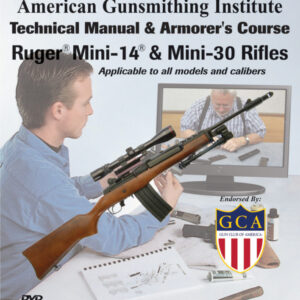Description
The Lee-Enfieldbolt-action, magazine-fed, repeating rifle was the main firearm used by the military forces of the British Empire/Commonwealth during the first half of the 20th century. It is felt by many experts to be the best battlefield bolt-action rifle ever issued. In its L-42 sniper version, it remained in service until 1993. It is still in service in some of the commonwealth countries. International armaments expert, John Bush, gives you the complete instructions for disassembly to the last screws and pins, inspection, cleaning, and reassembly that will make you an expert on the care of these guns.
This course is designed to help all of you owners who love the gun to understand clearly, how to identify all the Enfield variations and many rare accessories are shown. It also covers repairs and sporterizing. In true AGI fashion, we use a factory cut-a way gun that allows you to actually see how the various (normally hidden) parts work and interact. If you want the quick course on how to get this timeless, classic, bolt action rifle apart, back together, and operating as intended, then this course is for you (if you want the long course, look into our basic 108 hour Professional Gunsmith Course.)
Among the items covered are:
History
- Short Magazine Lee Enfield (S.M.L.E.) replaced the earlier Lee-Medford in 1895 and was designed to be used by all branches of the British Military. No more different rifles for the Infantry, Cavalry, Artillery, Navy, and Royal Marines.
- Lucky for us, the rear stock collar contains the date of manufacture, model number, mark number, and other useful information
- What the large hole in the side of the buttstock is for
- Why you need to pay attention to this video so you do not end up sporterizing a valuable collector rifle
- Australians only manufactured No. 1 MK III rifles
- What a wire, or cord wrap, or sheet metal clamp around the hand guard can mean
- Indian (Ishapore) guns, again, No. 1 MK IIIs, were the only ones originally made in .308/7.62 NATO because of the late date of their manufacture (and service)
- Differences between the No. 1 and the No. 4 are shown and described
- A No. 5 Jungle Carbine is shown
- Several different styles of No. 4 rear sights shown
- Several .22s, both purpose built and conversions, that were built on Enfield actions for training
Design & Function
- Loading the Enfield, this is a rimmed case, so there is a proper way
- Safety operation shown and demonstrated
- Cock on closing and primary extraction defined and demonstrated
- Trigger operation demonstrated, along with an extreme close up and explanation of the two-stage system
- Function and operation of the extractor and ejector explained and demonstrated
- Striker and sear operation
- The sear and magazine catch spring, one and the same
- Lock up, the constant debate about rear locking lug guns, and why many consider them better for a military rifle
- The bolt head rotates! That is ok, it is supposed to
- Half cock operation
Disassembly
- Extensive disassembly and instructions on how to take apart those parts/assemblies not disassembled, such as the barrel, rear and front sights
- Bolt removal method from a No. 1, the two different versions of the No. 4, and disassembly
- Differences in the bolt heads of the No. 1 and the No. 4, and what the number on the bolt head means
- Differences between cocking pieces shown
- Firing pin removal shown and demonstrated and why you need the dreaded special tool
- Bolt head disassembly, and what to look for
- Removal of the stock and forearms and the differences between the No. 1 and the No. 4
- Disassembling the receiver and all of its parts is shown and performed
- Disassembling the safety, what to avoid
- Differences between the No. 1 and No. 4
- You get a good look at how the various parts fit together and interact (particularly the springs) after they are removed from the gun and John explains things
Cleaning & Lubrication
- AGI cleaning & lubrication methods shown, along with the reasons for their use
- Disassembling the magazine
- After cleaning, dry with airgun, hair dryer, or in the oven on Warm ~185-200 degrees (metal parts ONLY)
- Lubing the AGI way, and what kind we like
Reassembly
- Parts inspection, what to look for
- Bolt reassembly, including, cocking piece, firing pin and spring, bolt head, and extractor. Extractor rules discussed
- Bolt stop reassembled
- Magazine inspection and reassembly. Why the magazine followers bind in an Enfield if you press down in the center
- Receiver reassembly
- Stock and forearms reassembly, and why Enfields are different lengths in a rack. How to tell without a comparison what length the buttstock is
- Final reassembly and safety checks
- Headspace check
- The stock bolt projection gauge
Accessories
- Customizing the Enfield rifle
- Stocks
- Vintage ammo
- Specialized tools
- Spare parts
- Books and manuals
- Slings and other accessories
- Summary
Accuracy Assessment and Improvement
- Sharp rifling
- Pitting
- Rebarrel if it is not a collectible
- What to check for barrel bedding
- Forearm pressure spec, how to measure it, and how to adjust it
- Attaching the CATCo scope mount
Additional Information and Conclusions
If you noticed how often the terms explanation, “shown,” and demonstration are used, you may be getting some idea of why this course is necessary for any Enfield rifle owner, or someone who intends to be.




